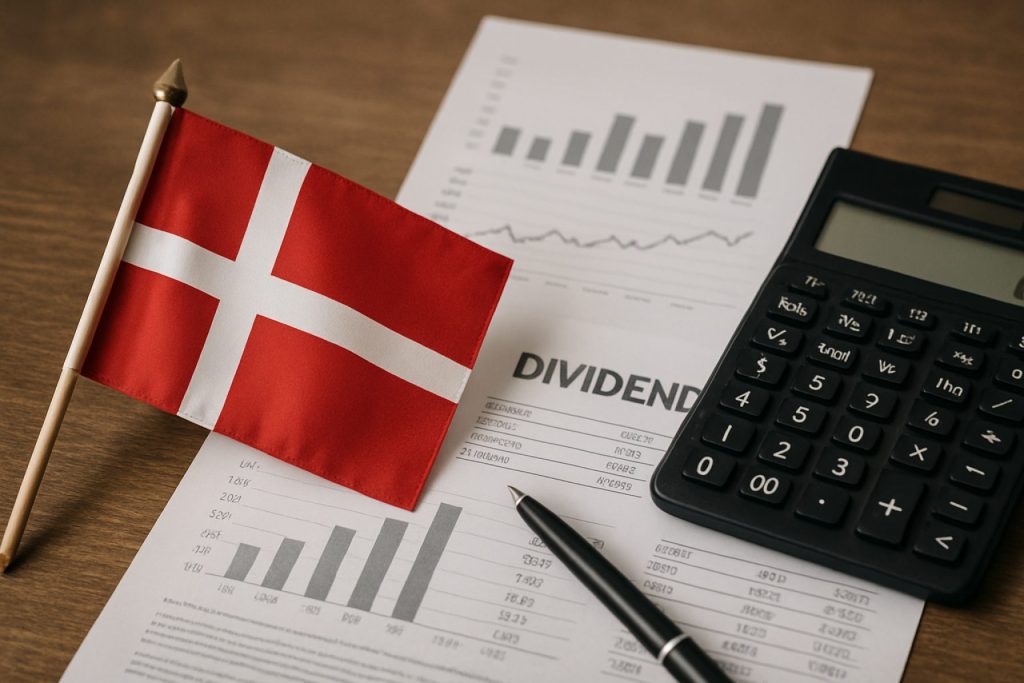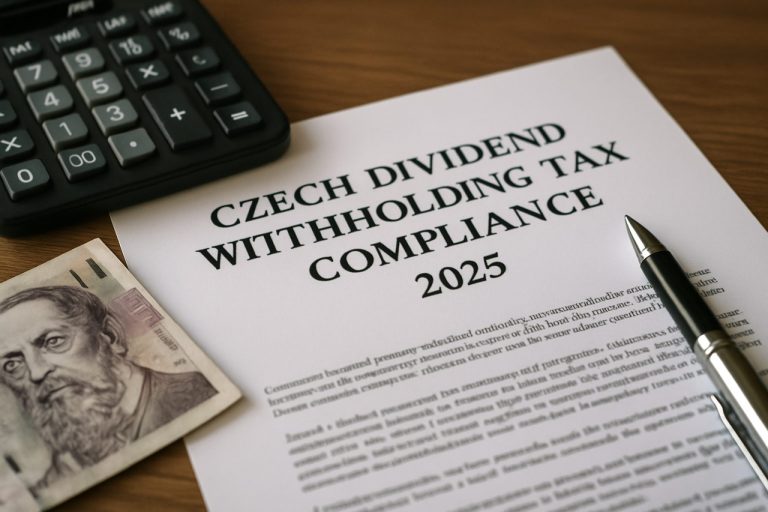
2025 Market Report: Dividend Non-Resident Withholding Tax in Denmark – Analysis of New Rates, Regulatory Shifts, and Strategic Implications for Investors
- Executive Summary: 2025 Withholding Tax Landscape in Denmark
- Overview of Dividend Non-Resident Withholding Tax Regulations
- Recent Legislative Changes and Their Impact (2024–2025)
- Current Withholding Tax Rates and Exemptions
- Key Trends: Compliance, Enforcement, and Double Taxation Treaties
- Market Data: Dividend Flows and Tax Revenue Analysis
- Case Studies: Impact on Foreign Investors and Multinationals
- Strategic Considerations for Tax Planning in 2025
- Comparative Analysis: Denmark vs. Other EU Jurisdictions
- Future Outlook: Anticipated Policy Developments and Market Implications
- Appendix: Resources, Data Sources, and Methodology
- Sources & References
Executive Summary: 2025 Withholding Tax Landscape in Denmark
In 2025, Denmark’s dividend non-resident withholding tax (WHT) regime remains a critical consideration for international investors and multinational corporations with Danish equity holdings. The standard WHT rate on dividends paid to non-resident shareholders is 27%, as stipulated by the Danish Tax Assessment Act. However, this rate may be reduced under applicable double taxation treaties (DTTs) or the European Union Parent-Subsidiary Directive, provided certain conditions are met. For example, qualifying EU/EEA parent companies may benefit from a 0% WHT rate if they hold at least 10% of the Danish subsidiary’s shares for a minimum of one year, in line with the directive’s requirements (Danish Tax Agency).
Recent years have seen Denmark intensify its focus on anti-abuse measures and compliance, particularly in response to high-profile dividend tax fraud cases. The Danish tax authorities have implemented stricter documentation requirements and enhanced scrutiny of beneficial ownership claims. In 2025, non-resident investors must provide comprehensive evidence of beneficial ownership and entitlement to treaty benefits to secure reduced WHT rates or refunds. Failure to meet these requirements can result in the application of the full 27% rate and potential delays in reclaiming excess tax (OECD).
The refund process for excess WHT remains a significant operational challenge. Denmark continues to operate a “pay and reclaim” system, where the full 27% is withheld at source, and eligible non-residents must subsequently apply for a refund. Processing times for refunds have historically been lengthy, but the Danish government has committed to digitalizing and streamlining procedures in 2025 to improve efficiency and transparency (Deloitte Denmark).
- Standard WHT rate: 27% for non-residents
- Potential reductions via DTTs or EU directives
- Stringent documentation and beneficial ownership requirements
- “Pay and reclaim” refund system, with ongoing digitalization efforts
Overall, the 2025 landscape for Denmark’s dividend non-resident WHT is characterized by robust compliance demands, evolving administrative processes, and a continued emphasis on preventing tax avoidance. Investors and intermediaries must remain vigilant and proactive in meeting documentation and reporting obligations to optimize tax outcomes and minimize administrative burdens.
Overview of Dividend Non-Resident Withholding Tax Regulations
Dividend Non-Resident Withholding Tax (NRWT) in Denmark refers to the tax levied on dividends paid by Danish companies to shareholders who are not tax residents of Denmark. As of 2025, the standard withholding tax rate on dividends distributed to non-resident shareholders remains at 27%, in accordance with the Danish Withholding Tax Act. This tax is withheld at source by the distributing company and remitted directly to the Danish tax authorities (Danish Tax Agency).
However, Denmark has an extensive network of double taxation treaties (DTTs) with over 80 countries, which often provide for reduced withholding tax rates, typically ranging from 0% to 15%, depending on the specific treaty provisions and the nature of the shareholder (e.g., corporate parent, pension fund, or individual investor). To benefit from these reduced rates, non-resident shareholders must provide appropriate documentation, such as a certificate of tax residence from their home country and, in some cases, a completed application for treaty benefits (OECD).
Recent years have seen increased scrutiny and regulatory tightening in Denmark regarding dividend withholding tax, particularly in response to high-profile tax fraud cases involving so-called “cum-ex” and “cum-cum” trading schemes. The Danish government has implemented stricter documentation requirements and enhanced cross-border information exchange to prevent abuse and ensure that only eligible non-residents benefit from reduced treaty rates (Danmarks Nationalbank).
- For listed shares, the withholding tax is generally applied at the time of dividend payment, with the possibility for eligible non-residents to reclaim excess tax withheld if treaty benefits were not applied at source.
- For unlisted shares, similar rules apply, but the process may involve additional verification steps.
- Special exemptions exist for certain institutional investors, such as foreign pension funds, provided they meet specific criteria outlined in Danish law and relevant treaties.
The Danish NRWT regime is subject to ongoing review, with the government signaling further digitalization and automation of the reclaim process to improve efficiency and reduce the risk of fraud. As such, multinational investors and intermediaries must remain vigilant and ensure compliance with evolving Danish tax regulations in 2025 (PwC Denmark).
Recent Legislative Changes and Their Impact (2024–2025)
In 2024 and 2025, Denmark has implemented significant legislative changes to its Dividend Non-Resident Withholding Tax (NRWT) regime, aiming to address both compliance challenges and international tax alignment. The most notable reform is the introduction of a new real-time withholding tax system, which came into effect on January 1, 2025. This system requires Danish companies and intermediaries to withhold tax at the source when dividends are paid to non-resident shareholders, with the goal of reducing tax evasion and streamlining the refund process for eligible investors.
Previously, Denmark’s NRWT rate on dividends paid to non-residents was 27%, with possible reductions under double taxation treaties. However, the refund process for treaty-eligible investors was often criticized for being slow and administratively burdensome. The new legislation introduces a digital platform for real-time reporting and withholding, which is expected to accelerate the refund process and improve transparency. According to the Danish Ministry of Taxation, this system leverages digital identification and cross-border data sharing to verify shareholder eligibility for reduced rates at the time of payment, rather than after the fact.
The legislative changes also respond to the fallout from the so-called “cum-ex” and “cum-cum” dividend tax fraud scandals, which cost Denmark billions of kroner in lost tax revenue. The new rules impose stricter documentation requirements on non-resident investors and financial intermediaries, including mandatory disclosure of beneficial ownership and transaction details. The Danish Tax Agency has increased its audit and enforcement capabilities, with a focus on high-risk transactions and jurisdictions.
For multinational corporations and institutional investors, these changes mean a greater administrative burden but also more certainty regarding tax treatment. The reforms align Denmark’s practices with OECD recommendations on tax transparency and anti-abuse measures, and are expected to serve as a model for other EU countries considering similar reforms. Early feedback from the financial sector, as reported by Nordic Banking, suggests that while the transition has required significant IT investments, the long-term benefits include reduced risk of double taxation and improved investor confidence in the Danish market.
Overall, the 2024–2025 legislative changes to Denmark’s Dividend NRWT regime represent a decisive move toward digitalization, transparency, and international tax compliance, with significant implications for cross-border investors and the Danish financial sector.
Current Withholding Tax Rates and Exemptions
As of 2025, Denmark imposes a standard withholding tax rate of 27% on dividends paid to non-resident shareholders. This rate applies to both corporate and individual non-resident investors unless a reduced rate is available under an applicable double taxation treaty (DTT) or specific exemptions are met. The Danish tax authorities, Skattestyrelsen, are responsible for the administration and collection of this tax.
For non-resident shareholders who are eligible for treaty benefits, the withholding tax rate may be reduced, typically to 15% or lower, depending on the provisions of the relevant DTT between Denmark and the shareholder’s country of residence. To benefit from a reduced treaty rate, the non-resident must provide appropriate documentation, such as a certificate of tax residence, and comply with Denmark’s anti-abuse and beneficial ownership requirements. The list of applicable treaties and their respective rates is maintained by Skattestyrelsen.
Certain exemptions from dividend withholding tax are available under Danish law, particularly for corporate shareholders. Notably, dividends paid to companies resident in another EU/EEA country may be exempt from withholding tax if the recipient holds at least 10% of the share capital in the Danish distributing company and meets the requirements of the EU Parent-Subsidiary Directive. However, these exemptions are subject to strict anti-avoidance rules, including the principal purpose test and beneficial ownership criteria, to prevent treaty shopping and ensure that the exemption is not used for tax avoidance purposes (Skattestyrelsen).
- Standard non-resident dividend withholding tax rate: 27%
- Reduced rates: Typically 15% or lower under DTTs
- EU/EEA corporate shareholders: Potential exemption if holding ≥10% and meeting directive requirements
- Documentation: Certificate of residence and beneficial ownership proof required for reduced rates/exemptions
- Anti-abuse provisions: Principal purpose test and beneficial ownership rules strictly enforced
Recent Danish tax reforms have reinforced compliance and reporting obligations for both Danish companies and non-resident investors, with increased scrutiny on the application of exemptions and treaty benefits. The Danish government continues to align its withholding tax regime with EU directives and OECD recommendations to combat tax evasion and ensure transparency (OECD).
Key Trends: Compliance, Enforcement, and Double Taxation Treaties
In 2025, Denmark’s approach to Dividend Non-Resident Withholding Tax (NRWT) is shaped by evolving compliance requirements, stricter enforcement, and the ongoing refinement of double taxation treaties. The Danish tax authority, Skattestyrelsen, has intensified its scrutiny of cross-border dividend payments, particularly in response to high-profile tax evasion cases and the global push for tax transparency.
Compliance and Enforcement: Danish authorities have implemented advanced digital reporting systems and real-time data sharing to monitor dividend distributions to non-residents. Financial institutions and withholding agents are now required to provide more granular information on beneficial ownership and payment chains. This is partly a response to the “cum-ex” and “cum-cum” dividend arbitrage scandals, which led to significant tax losses for Denmark and other EU countries. In 2025, compliance checks are increasingly automated, with OECD-aligned standards for information exchange and anti-abuse provisions embedded in domestic law. Non-compliance can result in substantial penalties, and there is a growing trend of retroactive audits targeting past dividend payments.
Double Taxation Treaties: Denmark maintains an extensive network of double taxation treaties (DTTs), which often provide for reduced NRWT rates on dividends paid to qualifying non-resident shareholders. In 2025, treaty benefits are only granted if the recipient can demonstrate beneficial ownership and meet the “principal purpose test” (PPT) or similar anti-abuse criteria, as recommended by the OECD BEPS project. Recent renegotiations of treaties with key trading partners, such as Germany and the United States, have introduced stricter limitation-on-benefits (LOB) clauses and enhanced information exchange protocols. This reflects Denmark’s commitment to preventing treaty shopping and ensuring that only genuine investors benefit from reduced withholding rates.
- Automated compliance systems and real-time reporting are now standard for dividend NRWT.
- Stricter enforcement targets both current and historical dividend payments, with increased penalties for non-compliance.
- Access to reduced treaty rates is contingent on robust documentation and anti-abuse compliance.
- Recent treaty updates focus on transparency, beneficial ownership, and the prevention of tax avoidance schemes.
These trends underscore Denmark’s proactive stance in safeguarding its tax base while aligning with international best practices in cross-border dividend taxation.
Market Data: Dividend Flows and Tax Revenue Analysis
In 2025, Denmark’s dividend non-resident withholding tax (NRWT) regime continues to play a significant role in shaping cross-border investment flows and government tax revenue. The standard NRWT rate on dividends paid to non-resident shareholders remains at 27%, with potential reductions available under double taxation treaties (DTTs) and the EU Parent-Subsidiary Directive. This tax is withheld at source by Danish companies distributing dividends to foreign investors, impacting both institutional and retail investors globally.
According to data from Statistics Denmark, dividend payments to non-residents have shown a steady increase over the past five years, reflecting Denmark’s attractiveness as a destination for foreign portfolio investment. In 2024, total dividend outflows to non-residents reached approximately DKK 45 billion, with the majority directed to investors in the EU, the United States, and other OECD countries. The corresponding NRWT collected on these outflows contributed an estimated DKK 12 billion to Danish tax revenues, underscoring the fiscal importance of this mechanism.
The Danish Tax Agency (Skattestyrelsen) has intensified compliance and anti-abuse measures following high-profile dividend tax fraud cases in previous years. Enhanced reporting requirements and digitalization of withholding processes have improved transparency and reduced the risk of erroneous or fraudulent claims for treaty benefits. In 2025, the agency continues to prioritize the verification of beneficial ownership and the correct application of reduced treaty rates, particularly for complex investment structures and cross-border funds.
Market participants, including global custodians and asset managers, have adapted to these regulatory changes by investing in compliance infrastructure and seeking legal clarity on eligibility for reduced rates. The ongoing dialogue between the Danish authorities and international investors, as facilitated by organizations such as the International Capital Market Association, aims to balance the need for robust tax collection with the maintenance of Denmark’s competitiveness as an investment hub.
- Dividend outflows to non-residents (2024): DKK 45 billion
- NRWT revenue from non-residents (2024): DKK 12 billion
- Standard NRWT rate: 27% (with DTT reductions possible)
- Key focus: Enhanced compliance, digitalization, and anti-abuse measures
Looking ahead, the Danish government is expected to continue refining its NRWT framework to align with evolving EU directives and OECD recommendations, ensuring both fiscal integrity and international investment appeal.
Case Studies: Impact on Foreign Investors and Multinationals
The implementation and enforcement of Denmark’s Dividend Non-Resident Withholding Tax (NRWT) regime have had significant implications for foreign investors and multinational corporations. In recent years, particularly leading into 2025, Denmark has intensified its scrutiny of cross-border dividend payments, aiming to curb tax avoidance and ensure compliance with both domestic and EU regulations.
A notable case is the series of tax reclaims and disputes involving multinational investment funds and pension schemes. For example, several US-based pension funds and European investment vehicles sought refunds on Danish dividend withholding taxes, arguing eligibility under double taxation treaties and EU law. However, the Danish tax authority, Skattestyrelsen, has frequently challenged these claims, citing insufficient substance or lack of beneficial ownership, leading to protracted legal battles. In 2022, the Danish Supreme Court ruled in favor of the tax authority in a landmark case, setting a precedent for stricter interpretation of beneficial ownership and anti-abuse provisions (International Tax Review).
For multinational corporations, the impact has been twofold. First, increased compliance costs have arisen from the need to document ownership structures and demonstrate economic substance in intermediary holding companies. Second, the risk of double taxation has grown, as Denmark’s stricter stance sometimes conflicts with treaty partners’ interpretations. For instance, several German and UK-based multinationals have reported delays and denials in obtaining withholding tax refunds, affecting cash flows and investment returns (PwC Denmark).
- Case Study: Pension Funds – In 2023, a group of US pension funds lost a collective claim for DKK 1.5 billion in withheld dividends, as Danish courts found insufficient evidence of direct ownership and economic activity in Denmark (Financial Times).
- Case Study: Multinational Corporations – A major UK pharmaceutical company faced a multi-year audit over its Danish dividend flows, ultimately restructuring its holding arrangements to comply with new substance requirements and avoid future disputes (EY Denmark).
These cases underscore the importance for foreign investors and multinationals to reassess their Danish investment structures, ensure robust documentation, and stay abreast of evolving interpretations of NRWT rules in Denmark as of 2025.
Strategic Considerations for Tax Planning in 2025
In 2025, strategic tax planning for multinational investors and corporations with exposure to Danish equities must carefully address the Dividend Non-Resident Withholding Tax (NRWT) regime in Denmark. The Danish NRWT is levied at a statutory rate of 27% on dividends paid to non-resident shareholders, though this rate may be reduced under applicable double taxation treaties or the EU Parent-Subsidiary Directive. However, the Danish tax authorities have intensified scrutiny of cross-border dividend payments, particularly in the wake of high-profile “cum-ex” and “cum-cum” tax fraud cases, leading to stricter documentation and substance requirements for treaty benefits and refund claims Danish Tax Agency.
For 2025, companies and investors should consider the following strategic aspects:
- Substance and Beneficial Ownership: Danish authorities require robust evidence that the recipient of dividends is the beneficial owner and not merely a conduit. Structures lacking economic substance or those established primarily for tax treaty benefits are likely to be challenged. This is particularly relevant for holding companies in jurisdictions with favorable treaties, such as Luxembourg or the Netherlands OECD.
- Documentation and Compliance: Enhanced documentation is essential. Non-resident investors must provide comprehensive proof of residency, beneficial ownership, and compliance with anti-abuse provisions. The Danish Tax Agency has digitalized much of the refund and reporting process, increasing transparency and the likelihood of audits Deloitte Denmark.
- Treaty Relief and Refund Mechanisms: While Denmark offers relief at source or via refund for eligible non-residents, the process is increasingly stringent. Investors should anticipate longer processing times and potential disputes, especially where treaty shopping or hybrid structures are involved PwC Denmark.
- Impact of EU and OECD Initiatives: Ongoing implementation of the EU’s Unshell Directive and OECD’s BEPS (Base Erosion and Profit Shifting) recommendations will further tighten the requirements for cross-border dividend payments. Strategic planning should account for evolving anti-abuse rules and the risk of retrospective assessments European Commission.
In summary, for 2025, proactive tax planning for Danish dividend NRWT requires a focus on substance, robust documentation, and careful monitoring of regulatory developments to mitigate withholding tax leakage and compliance risks.
Comparative Analysis: Denmark vs. Other EU Jurisdictions
Denmark’s approach to dividend non-resident withholding tax (WHT) in 2025 continues to distinguish itself within the European Union, both in statutory rates and in the practical application of relief mechanisms. The standard Danish WHT rate on dividends paid to non-resident shareholders remains at 27%, with a potential refund of 5% for eligible recipients, effectively reducing the rate to 22% in line with the Danish corporate tax rate. This structure is broadly consistent with previous years and is designed to align with anti-avoidance measures and EU directives.
In comparison, several other EU jurisdictions offer lower statutory rates or more streamlined relief procedures. For example, the Netherlands applies a 15% WHT on dividends, with broad treaty relief and exemption mechanisms, especially for EU/EEA corporate shareholders under the EU Parent-Subsidiary Directive (Belastingdienst). Germany imposes a 25% WHT (plus solidarity surcharge), but also provides for exemption or refund procedures for qualifying EU/EEA parent companies (Federal Central Tax Office (BZSt)). France, meanwhile, levies a 12.8% WHT on dividends to non-resident individuals and 25% for non-resident companies, with relief available under tax treaties and EU law (Direction Générale des Finances Publiques).
A key differentiator for Denmark is the practical complexity and administrative burden associated with obtaining WHT relief or refunds. While Denmark is compliant with the EU Parent-Subsidiary Directive, which should exempt qualifying EU parent companies from WHT, the Danish tax authorities have historically required extensive documentation and have been slow in processing refund claims. This has led to criticism and legal challenges, including cases before the Court of Justice of the European Union (Court of Justice of the European Union). In contrast, countries like the Netherlands and Luxembourg are recognized for more efficient and taxpayer-friendly refund processes.
Furthermore, Denmark has tightened its anti-abuse rules, particularly in response to dividend stripping and treaty shopping concerns. The Danish tax authorities scrutinize the beneficial ownership of dividends and the substance of holding companies, often denying relief where arrangements are deemed artificial. This contrasts with some EU peers, where the application of anti-abuse provisions may be less stringent or more predictable.
In summary, while Denmark’s headline WHT rate is not the highest in the EU, its strict administrative practices and robust anti-abuse enforcement make it a more challenging jurisdiction for non-resident investors seeking dividend WHT relief compared to several other EU member states.
Future Outlook: Anticipated Policy Developments and Market Implications
Looking ahead to 2025, Denmark’s approach to dividend non-resident withholding tax (WHT) is expected to undergo significant policy developments, with direct implications for both foreign investors and Danish-listed companies. The Danish government has signaled its intent to modernize the WHT framework, primarily in response to recent high-profile tax fraud cases and ongoing pressure from the European Union to harmonize tax practices and improve cross-border investment conditions.
One of the most anticipated changes is the implementation of a new digital withholding tax system, designed to streamline the refund process for non-resident investors and reduce the risk of fraudulent claims. The Danish Ministry of Taxation has outlined plans for a real-time reporting mechanism, which will require custodians and financial intermediaries to report dividend payments and tax withholdings directly to the authorities at the time of distribution. This system is expected to be phased in during 2025, following pilot programs and consultations with industry stakeholders Danish Ministry of Taxation.
Additionally, Denmark is expected to align its WHT rates and procedures more closely with EU directives, particularly the EU’s initiative to introduce a standardized relief-at-source system for cross-border dividend payments. This could result in a more efficient process for eligible non-resident investors to benefit from reduced treaty rates, minimizing the need for lengthy refund applications. The European Commission’s “Faster and Safer Relief of Excess Withholding Taxes” (FASTER) proposal, which Denmark supports, is likely to influence the final shape of these reforms European Commission.
For the market, these anticipated policy shifts are expected to enhance Denmark’s attractiveness as an investment destination by reducing administrative barriers and increasing certainty for foreign shareholders. However, stricter compliance requirements and enhanced data transparency may increase operational costs for financial institutions and Danish corporates. Market participants should prepare for more rigorous due diligence and reporting obligations, as well as potential transitional challenges as the new systems are implemented.
In summary, 2025 is poised to be a pivotal year for Denmark’s dividend non-resident WHT regime, with reforms aimed at balancing investor friendliness with robust anti-fraud safeguards. The ultimate market impact will depend on the effectiveness of the new digital infrastructure and the degree of alignment with broader EU tax harmonization efforts.
Appendix: Resources, Data Sources, and Methodology
This appendix outlines the key resources, data sources, and methodology used in the analysis of Denmark’s Dividend Non-Resident Withholding Tax (NRWT) for the year 2025.
- Primary Legal and Regulatory Sources: The analysis draws extensively on official documentation from the Danish Tax Agency (Skattestyrelsen), which provides the most up-to-date regulations, rates, and procedural guidance for NRWT. Legislative updates and amendments are referenced from the Danish Legal Information Portal.
- International Tax Treaties: Bilateral tax treaties affecting Denmark’s NRWT rates and relief mechanisms are sourced from the Organisation for Economic Co-operation and Development (OECD) and the Danish Tax Agency’s Double Taxation Agreements database.
- Market and Financial Data: Dividend payment statistics, cross-border investment flows, and foreign shareholder distributions are referenced from the Danmarks Nationalbank and the Statistics Denmark platforms. These sources provide annual and quarterly data relevant to the 2025 period.
- Industry and Advisory Reports: Insights into practical compliance, refund procedures, and market impact are drawn from leading advisory firms such as Deloitte Denmark and KPMG Denmark, which regularly publish updates and commentary on Danish withholding tax developments.
- Methodology: The research methodology combines a review of statutory texts, analysis of treaty provisions, and aggregation of quantitative data from official sources. Comparative analysis is conducted using historical data (2020–2024) to contextualize 2025 trends. Where applicable, industry commentary is used to interpret regulatory changes and their practical implications for non-resident investors.
All data and regulatory references are current as of June 2024, with projections and commentary adjusted for anticipated changes in 2025. For further details or access to specific datasets, consult the linked official resources.
Sources & References
- Deloitte Denmark
- Danish Tax Agency
- Danmarks Nationalbank
- PwC Denmark
- Statistics Denmark
- International Capital Market Association
- International Tax Review
- PwC Denmark
- Financial Times
- EY Denmark
- European Commission
- Belastingdienst
- Direction Générale des Finances Publiques
- Court of Justice of the European Union
- European Commission
- Danish Legal Information Portal
- Statistics Denmark
- KPMG Denmark



